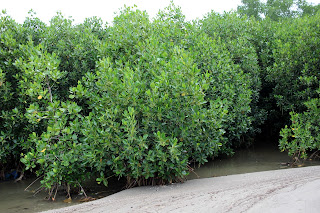kaffir lime is a shrub that belongs to the citrus family. It is called suwa in Northern Mindanao, Philippines. The plant can grow up to about 4 meters tall and is easily distinguishable from other citrus plants because of its distinctive “double leaf” look of leaves. Like some citrus shrubs, it has no trunk in the base but stems and branches that have sharp spines.
Suwa has leaves with pleasant limy aroma and small
white flowers. Its fruit is excessively sour even when fully ripe. It is ovate
in shape with thick skin. Inside it is pulpy juice-containing segments. Because
of its sourness, suwa is not commonly consumed by people as a table
fruit but as ingredient and flavor for dish especially kinilaw, the Filipino
version of the Mexican ceviche. Cebuano speaking people of Northern Mindanao
such as those in Cagayan de Oro are fond of eating kinilaw, a fresh fish-based
dish. Kinilaw is not complete without the indigenous ingredients of suwa,
tabon-tabon, siling labuyo (bird’s eye chili pepper), tuba
(coconut bud sap) and vinegar. Other ingredients can be optional depending on
the taste or likings of the one who prepares it as well as those who consume
it. A squeeze of suwa juice is also best to flavor a Filipino condiment
called bago-ong which is made from a brine fermented fish.
Because of its limited applications, suwa is not
grown in commercial scale, but are just mostly grown in the backyard where it
can be a decorative or fruit bearing shrub. A single plant of the ever-fruitful
Suwa can provide the house owner enough fruits for his needs all year
round.








